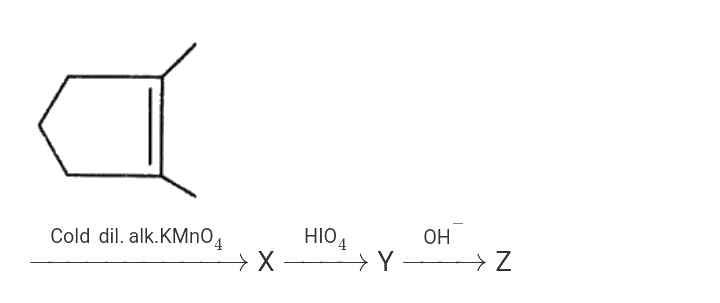2DCDOOH−−−→[X]and[Y] are
DCOO−,D2CHOH
HCOO−,CH3OH
HCOO−,CD3OH
DCOO−,CD3OH
The correct Answer is:D
To solve the question regarding the reaction of 2 moles of D-C-D-O in the presence of hydroxide (OH^(-)), we need to identify the products X and Y formed in this reaction, which is a type of Cain-Zarro reaction.
1. Identify the Reaction Type:
- The reaction is identified as a Cain-Zarro reaction, which involves two moles of carbonyl compounds that do not have alpha-hydrogens.
2. Understand the Reactants:
- The reactant is D-C-D-O, which is a deuterated carbonyl compound (D indicates deuterium, a hydrogen isotope).
3. Presence of Hydroxide Ion:
- The presence of hydroxide (OH^(-)) indicates that the reaction will involve both oxidation and reduction processes.
4. Oxidation Process:
- In the oxidation step, the carbonyl compound will be converted into a carboxylate ion. The general formula for a carboxylate ion derived from a carbonyl compound is RCOO^(-). In this case, it will be D-C(=O)O^(-).
5. Reduction Process:
- In the reduction step, the carbonyl compound will be reduced to an alcohol. The product will typically be in the form of R-OH. Here, it will be D-C-OH (deuterated alcohol).
6. Final Products:
- Therefore, the products of the reaction are:
- Product X: Carboxylate ion (D-C(=O)O^(-))
- Product Y: Alcohol (D-C-OH)
Conclusion:
The products X and Y formed from the reaction of 2 moles of D-C-D-O in the presence of hydroxide are:
- X: D-C(=O)O^(-) (Carboxylate ion)
- Y: D-C-OH (Deuterated alcohol)
- The reaction is identified as a Cain-Zarro reaction, which involves two moles of carbonyl compounds that do not have alpha-hydrogens.
- The reactant is D-C-D-O, which is a deuterated carbonyl compound (D indicates deuterium, a hydrogen isotope).
- The presence of hydroxide (OH^(-)) indicates that the reaction will involve both oxidation and reduction processes.
- In the oxidation step, the carbonyl compound will be converted into a carboxylate ion. The general formula for a carboxylate ion derived from a carbonyl compound is RCOO^(-). In this case, it will be D-C(=O)O^(-).
- In the reduction step, the carbonyl compound will be reduced to an alcohol. The product will typically be in the form of R-OH. Here, it will be D-C-OH (deuterated alcohol).
- Therefore, the products of the reaction are:
- Product X: Carboxylate ion (D-C(=O)O^(-))
- Product Y: Alcohol (D-C-OH)
The products X and Y formed from the reaction of 2 moles of D-C-D-O in the presence of hydroxide are:
- X: D-C(=O)O^(-) (Carboxylate ion)
- Y: D-C-OH (Deuterated alcohol)
Similar Questions
Knowledge Check
In the process of extraction of gold.
Roasted gold ore +CN−+H2OO2−−→[X]+OH−
[X]+Zn→[Y]+Au
Identify the complexes [X] and [Y].A[Au(CN)2]−,[Zn(CN)4]2−B[Au(CN)4]3−,[Zn(CN)4]2−C[Au(CN)2]2−,[Zn(CN)6]4−D[Au(CN)4]−.[Zn(CN)4]2−

Cold dil.alk ,KMnO4−−−−−−−−−−−→XHlO4−−→OH−−−→Z
In the above sequence of reaction, Z is
View SolutionIn the reaction sequence
C6H5CHONH2OH/H⊕−−−−−−−−→Δ(X)P2O5/Δ−−−−−→(Y)H2O,H+−−−−−→(Z)
(X), (Y) and (Z) respectively be
View SolutionIsopropylamine KMnO4−−−−→XH+3O−−→Y
In the above sequence X and Y are
View SolutionCHCl3+MeCOMeOH−−−→Aexcess KOH−−−−−−→BNaOH−CaO−−−−−−−→CKOBr−−→D
View SolutionCumene (i)O2−−−−−−−−−−→(II)H2O,H+(X) and (Y) ,
(X) and (Y)respectively are :
View SolutionIn the reaction sequence CH3−CO−CH3C2H5OH/OH−−−−−−−−−−→(A)C2H5OH/H+−−−−−−−−→[X] will be
View SolutionC2H5Cl + KCN →X Hydroysis−−−−−→Y, 'X' and 'Y' are:
View Solution
